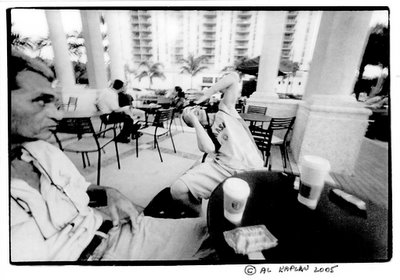Starbucks Diary cont'd ~ Crossing the Generations

Recognize the pose? This young contortionist is holding a loupe up to a sheet of my negatives.
Negatives are the very essence of traditinal photography. They contain far more information than you can ever get onto the final paper print. Movies have an advantage in that the final print is on film, and can contain a much longer scale. I tend to print contact sheets a bit on the flat low contrast side so that detail is visible in both the highlights and the shadows.
When it's time to make the final print your paper choice and the filter used with variable contrast paper gives you a lot of leeway in how the fnal print will look. You can also selectively burn in (darken) or dodge (lighten) areas. Sometimes I even do this through different filters to change the contrast in certain areas. You can emphasize various areas of the print in this way. I generally like a print with a full range of tones from pure black to at least a tiny bit of pure white, but I like seeng detail in both the highlight and shadow areas of the print.
You get to the point where you can look at the negative, or the image of it projected on the enlarger's baseboard, and even though all the tones are reversed black for white you have a very good idea of how well that negative will print. Some people claim they can visualize the finished print. I've never been able to really do that - look at the negative image and "see" a positive in my mind. What I can do is look at the image and know what needs to be done in printing to get where I want to go, to give me a print with the right contrast and I pretty much know what needs to be lighter or darker. The first try isn't always spot-on perfection but it's usually pretty close, certainly good enough to send on to the editor of the paper when a deadline loomed.
I keep a loupe in my truck along with a note pad and marking crayon because a relaxing cup of coffee is a great way to help decide what should be printed. Sometimes other people, mostly students from the 4 nearby colleges, want to take a peak or ask me to take a gander at their photos.A lively conversation usually ensues about which picture and why. Yes, film based photography is still being taught in our schools, and the biggest complaint seems to be about trying to schedule darkroom time. But it's not just students who strike up a conversation at the sight af a "real" camera. This afternoon I spent a half hour or so chatting with a gentleman of perhaps 70. He was sitting at the next table and noticed the name Voigtlander. We talked about how the name had been bought by Cosina, and they were making a series of various relatively inexpensive cameras compatible with Leica lenses, as well as some excellent and innovative optics that could also be used on Leica bodies. He talked about the 6x9cm Bessa that he once owned, using 120 roll film. The superb lens, the rangefinder focussing, the accurate Compur shutter, the beautiful brushed chrome and black leather finish of the camera. I told him that I had a working darkroom with an enlarger that would take that size negative, and tanks and reels for 120 film. We exchanged phone numbers and he left Starbucks smiling, thinking about going searching through a bunch of boxes looking for all his old negatives, and maybe even find the Bessa itself.

0 Comments:
Post a Comment
<< Home